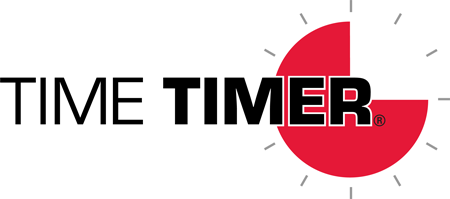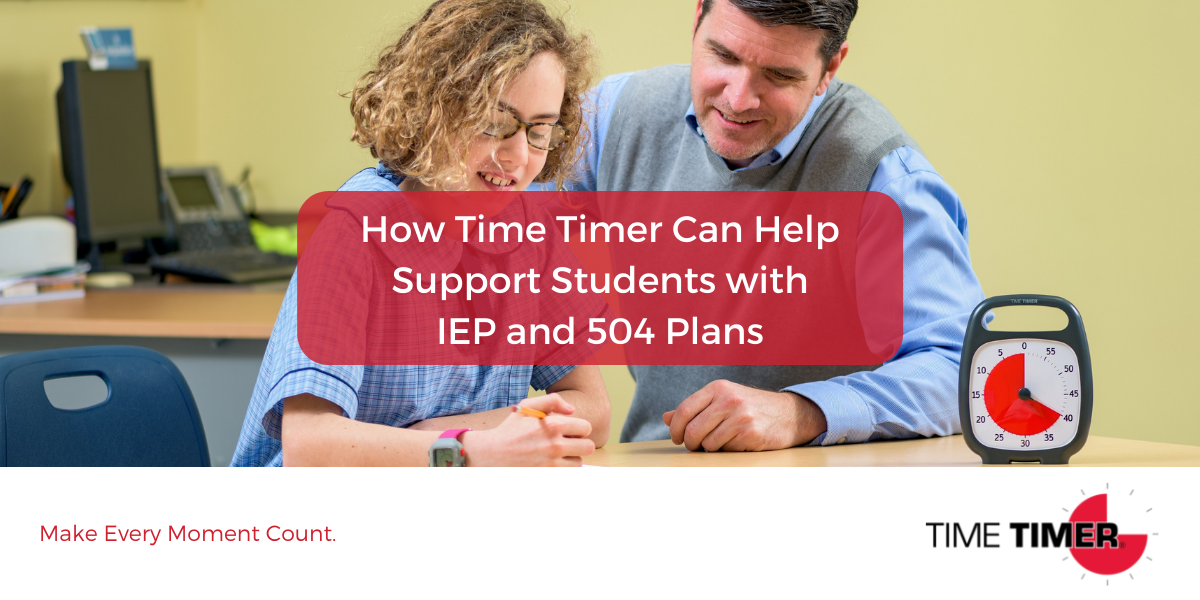Throughout the country, school is back in session – or will be quite soon, depending on where you live. Every family, teacher, and administrator across the country spends a great deal of time preparing for a return to the classroom. Some educators, students, and their parents will be devoting extra attention to creating or updating IEP and 504 Plans. If your child, student, or client has an IEP or 504 Plan, there are several ways Time Timer can step in and support them with time management awareness. This amazing “visual timer” does wonders to help people maintain focus and gain a better understanding of passing time, often critical to successful learning and academic achievement.
An Individualized Education Program (IEP) is covered under the Individuals with Disabilities Education Act (IDEA), which was reauthorized in 2004. Originally known as the “Education for All Handicapped Children Act”, it was first signed into law by President Gerald Ford in 1975.
This federal law (IDEA) guarantees a “free appropriate public education” (FAPE) to all children with disabilities.
According to the U.S. Department of Education, “IDEA governs how states and public agencies provide early intervention, special education, and related services to more than 7.5 million (as of the school year 2018-19) eligible infants, toddlers, children, and youth with disabilities.”
As defined by law and outlined in IDEA, “child with a disability” has been evaluated according to the law and results place them in one of the following 13 categories: Autism, Deaf-Blindness, Deafness, Emotional Disturbance, Hearing Impairment, Intellectual Disability, Multiple Disabilities, Orthopedic Impairment, Other Health Impairments, Specific Learning Disability, Speech or Language Impairment, Traumatic Brain Injury, Visual Impairment, or a child ages three through nine who are found to have a Developmental Disability.
In order to qualify for an IEP, a student must be evaluated with various screening tools by a trained psychologist, in conjunction with feedback provided by education professionals or others working with the student. Any data must demonstrate that the student’s disability affects their capacity to learn by some degree; and would require specialized instruction or concessions in order for them to progress academically in a general education classroom.
Additionally, a special education student not only is entitled to various curriculum modifications, but they also may receive other related support services such as occupational, physical, or speech therapy.
All of us at Time Timer are honored to be a part of a community of organizations providing assistive technology that supports and serves individuals of ALL abilities. Our products are affordable and may provide helpful assistance in a range of educational settings. According to a declaration established by the United States Congress in March 2019, assistive technology (AT) is “any item, piece of equipment, or product system that is used to increase, maintain, or improve the functional capabilities of people with disabilities and older adults.”
In comparison to an IEP, a 504 Plan is named for Section 504 of the Rehabilitation Act of 1973. As referenced by the Disability Rights Education & Defense Fund, Section 504 of the 1973 Rehabilitation Act was the first disability civil rights law to be enacted in the United States. It prohibits discrimination against people with disabilities in programs receiving federal financial assistance and set the precedent for the enactment of the Americans with Disabilities Act (ADA). Section 504 works together with the ADA and IDEA to protect children and adults with disabilities from exclusion, and unequal treatment in schools, jobs and the community.
Unlike IDEA, Section 504 does not list specific diagnoses covered by the law, yet includes examples of physical/mental impairments and mental/psychological disorders that would constitute a disability. The law lists “major life activities” including (but not limited to) self-care, performing manual tasks, walking, seeing, speaking, hearing, breathing, learning, and working.
A 504 Accommodation Plan is guided by the Americans with Disabilities Act (ADA) to ensure that a student with a disability has access to accommodations that improve academic functioning. For example, a 504 Plan also can provide for extended time during standardized or statewide testing for your child. It may also allow for accommodations like frequent breaks, fidget gadgets, or modified homework assignments (for example).
Unlike with an IEP, a 504 Plan does not make provisions for specialized instruction or related services, such as counseling or physical, speech, or occupational therapy. By default, students qualifying for an IEP are already covered by Section 504, and components of a 504 Plan are included within the IEP.
There’s no question, either an IEP or a 504 Accommodation plan can both play a huge role in supporting learners who need extra support in reaching their academic potential.
Time Timer offers a range of practical and helpful tools that help people visualize time in an engaging, easy-to-interpret way. Our mission is empowering people of all abilities to conquer time! Time Timer is an especially supportive aid in teaching time awareness for these individuals, as well as those with learning and sensory difficulties. These may include people with ADHD, autism spectrum disorder, Asperger’s Disorder, Dyslexia, executive function deficits, and many other cognitive and behavioral-related diagnoses.
When our company’s founder, Jan Rogers, invented Time Timer in 1994, she based her concept on the visualization of elapsed time in a clear, high-contrast format differing from traditional digital or analog clock formats. Following field research and consultation with professionals serving people with different abilities, it became apparent that Time Timer would be especially beneficial for people with cognitive, behavioral, and other challenges.
Children with these and other disabilities may have marked difficulty understanding the concept of “passing time”, where the difference between five minutes and 30 minutes is not clearly understood. Time Timer provides a stress-free solution and encourages responsible independence and autonomy, as well. For those with sensory issues, Time Timer is thoughtfully designed without any ticking noises, and may be used with or without an audible alarm at the end of a set time period.
Businesses, governments, and individuals alike; it’s important for all of us to foster a sense of inclusion throughout our schools and communities. This inclusion ultimately enriches life for everyone. We believe it’s up to each of us to ensure everyone has what they need to live their life to the fullest, no matter their perceived limitation or disability. Time Timer loves being a part of that philosophy!

